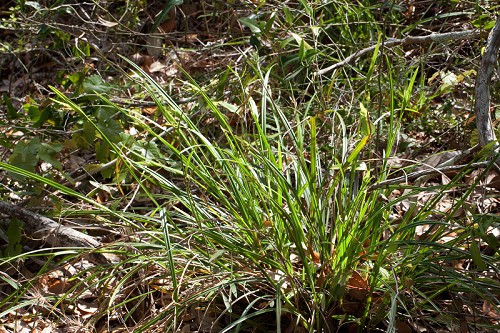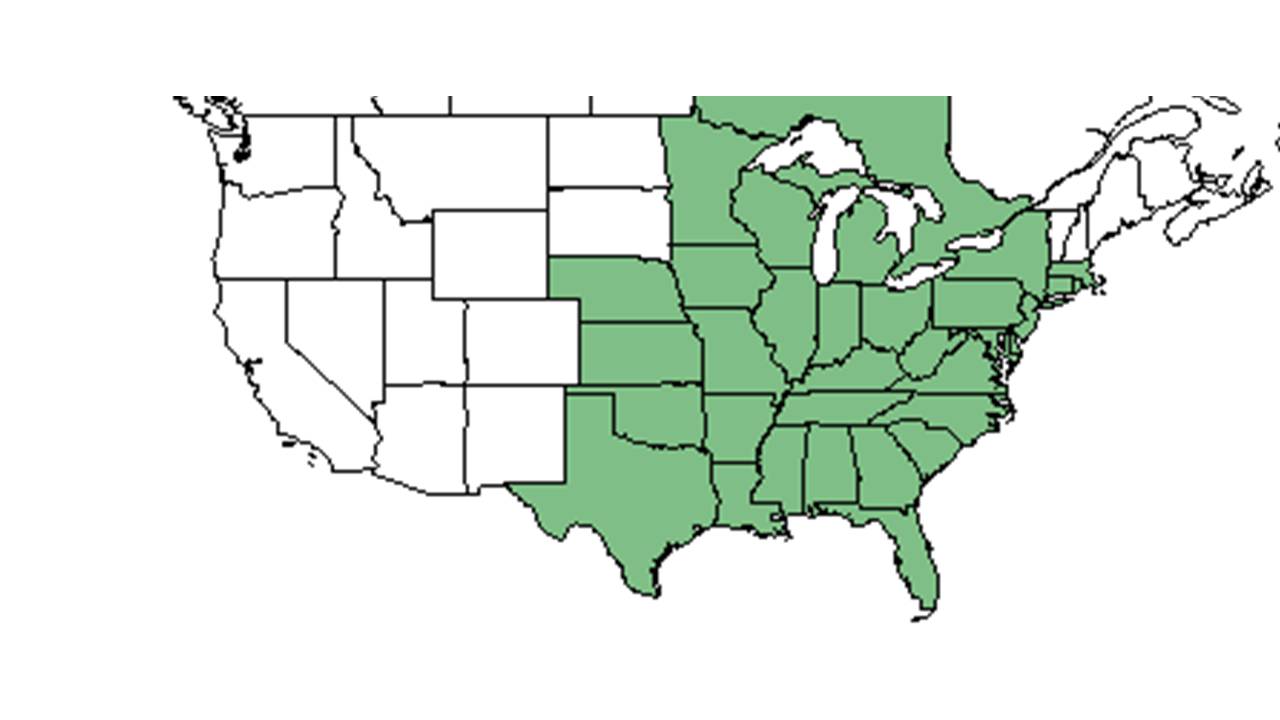Difference between revisions of "Scleria triglomerata"
(→Conservation and Management) |
Krobertson (talk | contribs) |
||
| Line 27: | Line 27: | ||
==Ecology== | ==Ecology== | ||
===Habitat=== <!--Natural communities, human disturbed habitats, topography, hydrology, soils, light, fire regime requirements for removal of competition, etc.--> | ===Habitat=== <!--Natural communities, human disturbed habitats, topography, hydrology, soils, light, fire regime requirements for removal of competition, etc.--> | ||
| − | It occurs in seepage slopes, interdunal pine flatwoods, edges of ponds and swamps, steepheads, live oak-cabbage palm hammocks, calcareous hammocks, swampy savannas with dwarf pond cypress, shaded floodplain woods, ''Sarracenia'' bogs, sand pine-Florida rosemary scrubs, hardwood hammocks, river banks under hardwood trees, and sandhill scrubs. Occurs in disturbed areas such as recently cleared woods and shrub bogs, fallow fields, power lines, and vehicle trails | + | It occurs in seepage slopes, interdunal pine flatwoods, edges of ponds and swamps, steepheads, live oak-cabbage palm hammocks, calcareous hammocks, swampy savannas with dwarf pond cypress, shaded floodplain woods, ''Sarracenia'' bogs, sand pine-Florida rosemary scrubs, hardwood hammocks, river banks under hardwood trees, and sandhill scrubs. Occurs in disturbed areas such as recently cleared woods and shrub bogs, fallow fields, power lines, and vehicle trails. <ref name="FSU Herbarium">Florida State University Robert K. Godfrey Herbarium database. URL: [http://herbarium.bio.fsu.edu http://herbarium.bio.fsu.edu]. Last accessed: June 2014. Collectors: Loran C. Anderson, Ed Keppner, Lisa Keppner, Robert K. Godfrey, Robert Kral, Mabel Kral, D. L. Fichtner, Cecil R Slaughter, K. Craddock Burks, George R. Cooley, Leonard J. Brass, William Reese, Paul Redfearn, James D. Ray, Jr., C. E. Wood, C. E. Smith, J. R. Eaton, Robert F. Thorne, Walter Judd, C. Jackson, R L Lazor, William Lindsey, Gil Nelson, R. A. Norris, Rodie White, Lisa Keppner, Marc Minno, Bob Fewster, Annie Schmidt. States and Counties: Florida: Bay, Citrus, Clay, Flagler, Franklin, Gulf, Hernando, Jackson, Jefferson, Leon, Liberty, Marion, Nassau, Okaloosa, Osceola, Taylor, Volusia, Wakulla, Walton, Washington. Georgia: Grady and Thomas. Compiled by Tall Timbers Research Station and Land Conservancy.</ref> Generally occurs in moist areas. Soils range from sand, mucky sand, loamy sand, sandy loam, and loam. Found in shady to open environments. <ref name="FSU Herbarium"/> Associated species include ''Carex venusta, Carex lonchocarpa, Rhynchospora, R. wrightiana, Magnolia ashei, Serenoa repens, Galucous form, Persea littoralis, Osmanthus, Morinda, Rapanea guianensis, Quercus geminata, Sarracenia, Scleria georgiana'', and ''S. pauciflora.'' <ref name="FSU Herbarium"/> |
===Phenology=== <!--Timing off flowering, fruiting, seed dispersal, and environmental triggers. Cite PanFlora website if appropriate: http://www.gilnelson.com/PanFlora/ --> | ===Phenology=== <!--Timing off flowering, fruiting, seed dispersal, and environmental triggers. Cite PanFlora website if appropriate: http://www.gilnelson.com/PanFlora/ --> | ||
| − | Flowers and fruits April through November | + | Flowers and fruits April through November. <ref name="FSU Herbarium"/> |
<!--===Seed dispersal===--> | <!--===Seed dispersal===--> | ||
<!--===Seed bank and germination===--> | <!--===Seed bank and germination===--> | ||
| Line 47: | Line 47: | ||
==References and notes== | ==References and notes== | ||
| − | |||
Revision as of 18:37, 8 August 2016
| Scleria triglomerata | |
|---|---|

| |
| Photo by John R. Gwaltney, Southeastern Flora.com | |
| Scientific classification | |
| Kingdom: | Plantae |
| Division: | Magnoliophyta – Flowering plants |
| Class: | Liliopsida – Monocotyledons |
| Order: | Cyperales |
| Family: | Cyperaceae |
| Genus: | Scleria |
| Species: | S. triglomerata |
| Binomial name | |
| Scleria triglomerata Michx. | |

| |
| Natural range of Scleria triglomerata from USDA NRCS Plants Database. | |
Common name: whip nutrush
Contents
Taxonomic notes
Description
A description of Scleria triglomerata is provided in The Flora of North America.
Distribution
Ecology
Habitat
It occurs in seepage slopes, interdunal pine flatwoods, edges of ponds and swamps, steepheads, live oak-cabbage palm hammocks, calcareous hammocks, swampy savannas with dwarf pond cypress, shaded floodplain woods, Sarracenia bogs, sand pine-Florida rosemary scrubs, hardwood hammocks, river banks under hardwood trees, and sandhill scrubs. Occurs in disturbed areas such as recently cleared woods and shrub bogs, fallow fields, power lines, and vehicle trails. [1] Generally occurs in moist areas. Soils range from sand, mucky sand, loamy sand, sandy loam, and loam. Found in shady to open environments. [1] Associated species include Carex venusta, Carex lonchocarpa, Rhynchospora, R. wrightiana, Magnolia ashei, Serenoa repens, Galucous form, Persea littoralis, Osmanthus, Morinda, Rapanea guianensis, Quercus geminata, Sarracenia, Scleria georgiana, and S. pauciflora. [1]
Phenology
Flowers and fruits April through November. [1]
Fire ecology
It is found in annually burned pinelands.
Conservation and management
Cultivation and restoration
Photo Gallery
References and notes
- ↑ 1.0 1.1 1.2 1.3 Florida State University Robert K. Godfrey Herbarium database. URL: http://herbarium.bio.fsu.edu. Last accessed: June 2014. Collectors: Loran C. Anderson, Ed Keppner, Lisa Keppner, Robert K. Godfrey, Robert Kral, Mabel Kral, D. L. Fichtner, Cecil R Slaughter, K. Craddock Burks, George R. Cooley, Leonard J. Brass, William Reese, Paul Redfearn, James D. Ray, Jr., C. E. Wood, C. E. Smith, J. R. Eaton, Robert F. Thorne, Walter Judd, C. Jackson, R L Lazor, William Lindsey, Gil Nelson, R. A. Norris, Rodie White, Lisa Keppner, Marc Minno, Bob Fewster, Annie Schmidt. States and Counties: Florida: Bay, Citrus, Clay, Flagler, Franklin, Gulf, Hernando, Jackson, Jefferson, Leon, Liberty, Marion, Nassau, Okaloosa, Osceola, Taylor, Volusia, Wakulla, Walton, Washington. Georgia: Grady and Thomas. Compiled by Tall Timbers Research Station and Land Conservancy.